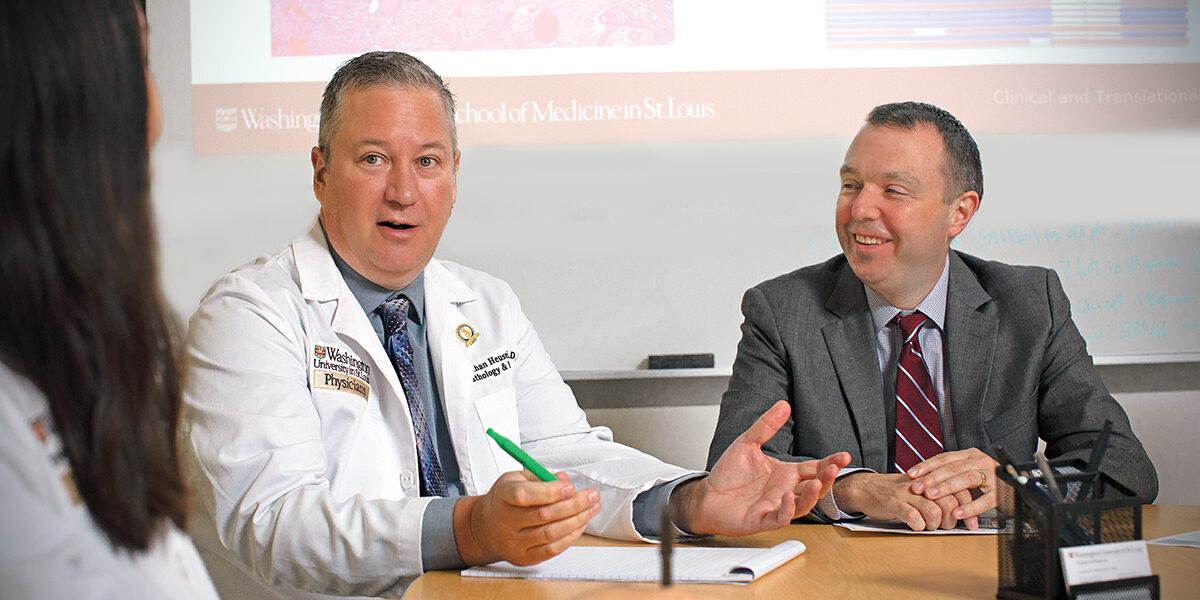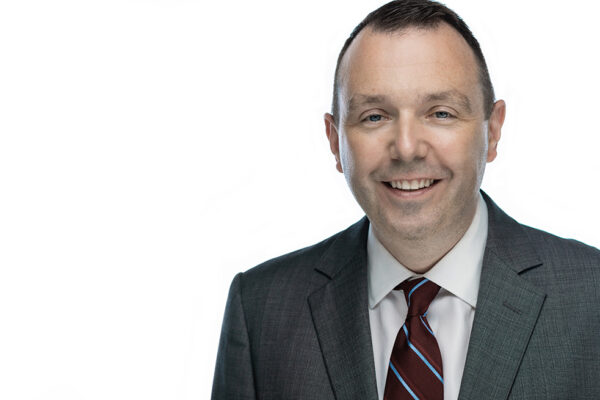Across higher education, universities have traditionally been broken up into schools, which then were divided further into departments, disciplines and specializations. The notion of collaboration as a means of real achievement sat there in plain sight but was often underutilized in the context of a university almost by design. Though collaboration may be one of the simplest, most effective means possible to achieve meaningful progress in any field, its deficiency begged a question: Is a commune of geniuses and well-decorated experts limited, at least to some degree, if they’re not combining resources and working collectively on problems?
“The way American higher education works, fortunately, is that administrators don’t tell individual faculty what to work on. That’s what makes it great: You have all these brilliant people pursuing their curiosity, wherever it leads them.”
Provost Holden Thorp
That historic structure has been challenged at Washington University — not only to strengthen intra-university relationships, but to solve real-world problems. A deeper dive into a few new or enhanced initiatives, programs and research, made possible in part by funding from the Leading Together campaign, shows how collaboration has taken hold at Washington University, particularly in the areas of sustainability, leadership, public health, and medicine and policy.
Outside Provost Holden Thorp’s office on the day of the scheduled interview, there’s a torrential downpour. The semester is in full swing, and the campus has fallen into its familiar hum. Thorp’s office, which overlooks Brookings Quadrangle, is filled to the brim with photos and books. Though no longer involved in active research, Thorp holds a PhD in chemistry from the California Institute of Technology and, over his career, has helped develop new drugs that inhibit metallo-enzymes. One such drug, called oteseconazole — used to treat fungal infections — is now in the third phase of clinical trials. His tenure at Washington University, which began July 1, 2013, was preceded by a five-year term as chancellor of the University of North Carolina at Chapel Hill.
As WashU’s chief academic administrator, while he still reviews tenure cases, Thorp takes great pride in staying out of the research faculty’s way. “The way American higher education works, fortunately, is that administrators don’t tell individual faculty what to work on. That’s what makes it great: You have all these brilliant people pursuing their curiosity, wherever it leads them,” Thorp says.
Thorp does, however, wade into broader issues in higher education as co-author of two books, Our Higher Calling: Rebuilding the Partnership Between America and Its Colleges and Universities (2018) and Engines of Innovation: The Entrepreneurial University in the Twenty-First Century (2010). He enthusiastically endorses new WashU initiatives such as the Joseph and Yvonne Cordell Institute for Policy in Medicine & Law, a collaboration between the medical and law schools, as mechanisms for future success.
“A lot of universities either can’t figure out a way to achieve collaboration between individual schools like that, or they don’t want to,” Thorp says. “But the founders of the Cordell Institute came up with the terrific idea to tap professors at our law school to help our medical researchers understand how to handle our genetic data findings. That’s a very important problem.”
Cordell Institute: considering how the law and medical research converge
The Cordell Institute, established by Joseph Cordell, LLM ’08, and Yvonne Cordell, JD ’88, is a vital arrangement between Washington University’s School of Medicine and School of Law that epitomizes the possibilities of collaboration. Forged in 2017, the institute is co-directed by Neil Richards, JD, the Thomas and Karole Green Professor of Law and an international leader in the field of privacy law, and Jonathan W. Heusel, MD ’95, PhD ’95, professor of pathology and genetics. Bridging the disciplines of law, medicine, science and ethics, the institute explores how new medical and information technologies can be legally deployed in the most effective, ethical ways possible.
Richards’ work in helping establish the academic field of privacy law gained national attention alongside the rise of the digital age, as smartphones, email and social networking sites gained prevalence. Born in England, he moved to the United States with his family when he was 11. To soften the blow of an international move, his parents bought him a computer — which was really a bribe, as he remembers it. After attending law school at the University of Virginia, Richards clerked for Chief Justice William H. Rehnquist of the U.S. Supreme Court and Chief Justice Paul V. Niemeyer of the U.S. Court of Appeals for the Fourth Circuit.
Richards says we’ve all witnessed firsthand what happens when powerful technologies aren’t structured, at least in part, by moral and practical considerations from the outset. For example, the political consulting firm Cambridge Analytica became well-known in the wake of the 2016 presidential election for gathering personal information from Facebook users for political gain without first obtaining consent.
“If your technology isn’t created with an ethical sensibility that protects users from the beginning, it’s very hard to bolt it on at the end,” Richards says. “Several companies have had very public struggles with that — not just with legal compliance, but with what builds trust among their users. The tools we need to tackle these issues are much broader than existing laws.”
It’s a principle that also applies to Heusel’s research, which focuses on translating medical discoveries into viable therapeutic treatments for patients. And like developing digital technology, ensuring that the research is done in a regulated, ethical way positions these revelatory treatments to stand the test of time.
“Particularly in the realm of cancer and other genetic diseases, we’re working at the interface of discovery and health- care solutions. In the 25 years I’ve been practicing medicine, I’ve seen an amazing transformation and extraordinary innovation,” Heusel says. “The Cordell Institute wants to develop policy that keeps pace with this kind of technology.”
Originally from a small town in Nebraska, Heusel thought he’d be a family-medicine physician like his father. But once he got to college in the ’80s, he became fascinated by the new science of molecular biology, cloning and studying individual genes. After graduating with an MD and a PhD in immunology from Washington University’s School of Medicine, Heusel continued studying genetics, laboratory medicine and clinical pathology. His current work in pathology at the medical school is heavily rooted in genomic sequencing, of not only healthy human DNA but also the DNA of different cancer cells and tumors.
Inasmuch as the medical school at Washington University was such a major player in the Human Genome Project, sequencing some 25 percent of the first human genome, forming the Cordell Institute was the logical next step in the evolution of precision medicine and beyond.
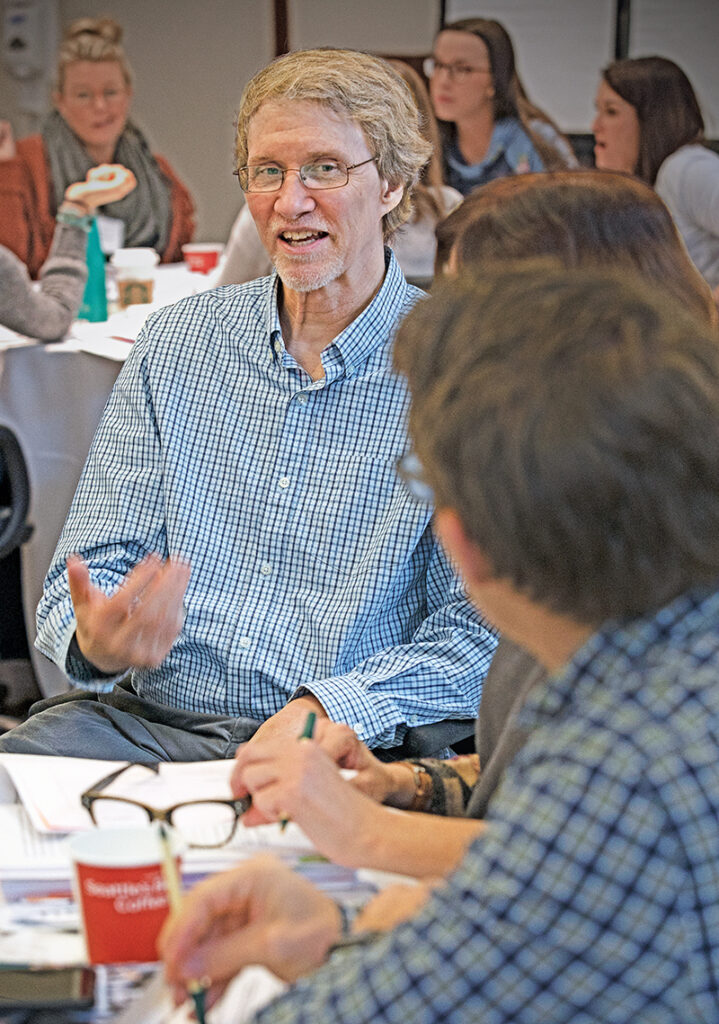
Institute for Public Health: focusing on community collaboration
Heusel and Richards also face the issue of long lag times between the discovery of impactful technologies and their implementation. Ross Brownson, PhD, recently appointed the Steven H. and Susan U. Lipstein Distinguished Professor in Public Health at the Brown School, also comes across this problem in his research. Brownson, who serves as co-director of the Prevention Research Center in the Institute for Public Health, a collaboration with Saint Louis University’s College of Social Justice and Public Health, says, “The pipeline from a discovery to when it is available to improve people’s lives can take many years. We’re working on implementation science to shorten that time span.”
Brownson’s work considers several public health issues affecting the U.S., one being chronic-disease prevention. Last year, he was awarded a $2.9 million grant from the National Cancer Institute to develop infrastructure to bolster physical activity in rural communities. Brownson notes that in the U.S., the importance of prevention and early detection are severely undervalued: A meager 3 percent to 6 percent of the federal health-care budget goes toward prevention, missing many opportunities to invest wisely in health. “We skip over what leads to long-term progress: things like prevention and early detection, healthy eating, not smoking, and prioritizing regular cancer screenings, such as mammograms,” he says.
Brownson had just finished graduate school and was working at a triathlon store in Fort Collins, Colorado, when a former professor offered him his first job in public health at the Missouri Department of Health. Working on initiatives aimed to prevent cancer and other chronic diseases, Brownson was confronted with a startling discovery. “State and local public- health agencies are the frontlines of what we do. They’re responsible for addressing the issues we study and serving the most vulnerable populations,” he says. “But we realized that too often these agencies implement programs that are ineffective and not evidence-based. They’re delivering things that should be significantly changed or stopped altogether.”
An example that needs to change, he says, is the D.A.R.E. program, or Drug Abuse Resistance Education. The program was developed in Los Angeles and soon made its way to public schools as required curriculum. “Our best evaluations show that it is not an effective program and requires a lot of resources, yet at one point it was one of the most widely implemented school-based programs in the country.”
Nancy Morrow-Howell, PhD, the Bettie Bofinger Brown Distinguished Professor in the Brown School and director of the Harvey A. Friedman Center for Aging in the Institute for Public Health, has similarly dedicated her life to community-based collaborations and research. A trained social worker, she found her calling in the study of aging during her doctoral studies at the University of California at Berkeley. She returned to St. Louis, her hometown, in 1987 to work with social work students at Brown and has been with the university ever since.
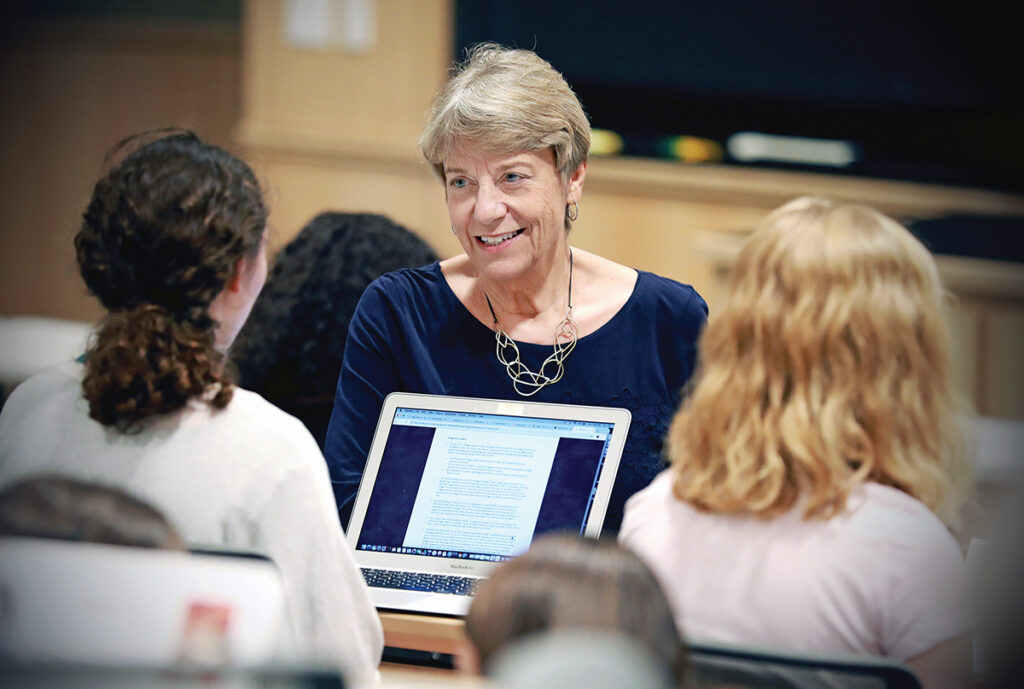
Morrow-Howell’s work largely concerns what has been dubbed “productive aging,” or how to maintain meaningful engagement during retirement age. As older adults leave the workforce, she points out, they’re often incorrectly perceived as no longer able to make valuable contributions to society. “We can’t afford that perspective. People are now often living 20 to 30 years past retirement, and we have to use that capacity for everyone’s benefit,” she says.
One community-based project that she evaluated and helped lead her to this conclusion is the Experience Corps, operated by the AARP Foundation. The program, active in 23 cities, selects older adults as volunteer tutors to work with children in underresourced public elementary schools. Morrow-Howell was awarded a substantial grant to document the effects on participants, and the results offered quantifiable evidence of the benefits for both age groups. Children’s reading levels improved, and the adult volunteers exhibited increased levels of well-being, functional ability and even a decrease in depressive symptoms.
“It shows that the kind of win-win you might predict with a program like that really exists,” she says. “Engaging older adults this way yields real economic value and taps into the highly underutilized resources of the older population.”
At the university level, Morrow-Howell predicts that as birth rates continue to slow, fewer young adults will pursue higher education, and universities will need to focus on programming for prospective students of all ages to remain vibrant. In line with this theory, Washington University has just joined the Age-Friendly University Global Network, made up of universities that commit to diversifying via age-inclusive offerings.
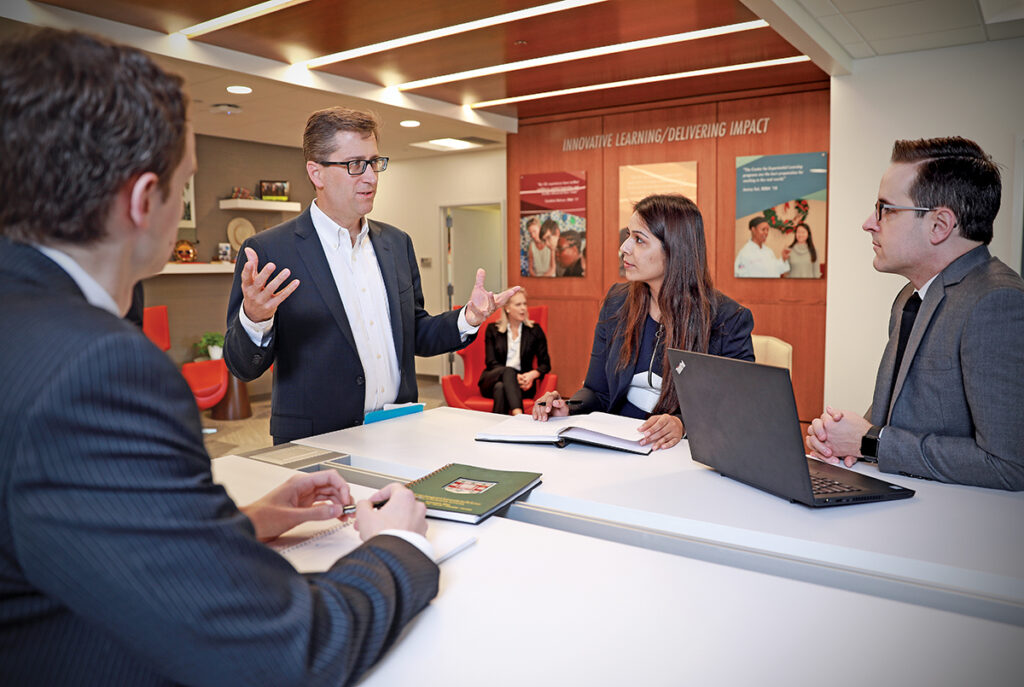
Bauer Leadership Center: teaching a values-based perspective
Although the corporate world may strike onlookers as more concerned with profits than ethics, the George and Carol Bauer Leadership Center at Olin Business School is teaching leaders how to achieve profit goals while maintaining a moral code. Further, the new initiative is building on the premise that it is through a moral code that leaders achieve real business solutions, doing away with tired business-culture stereotypes of the past. The university calls it values-based leadership, focused on honing evidence-based traits of good leaders.
“The relationship between business and ethics has always been something I’ve cared about,” says Stuart Bunderson, PhD, the George and Carol Bauer Professor of Organizational Ethics and Governance. Bunderson, who also serves as co-director of the Bauer Leadership Center, spent years studying business organization and management at PepsiCo, Inc. and Allina Health System before transitioning to his current roles at Olin.
While PepsiCo, for example, is seen as the best in the business for developing leaders, Bunderson noticed that it primarily rewards results-based leaders. “What we increasingly hear younger generations say is that they want to drive results in a way that means something more than just the bottom line,” he says. “I also had that sense when I was that age and somehow never lost it. I can relate to our younger students who tell us that they want meaning and significance in their work lives. Our programs outline how to help get them there.”
Bunderson confirms that students preparing for management roles in the workforce learn best by experience, which often is absent in MBA programs. Students at Olin, however, obtain valuable experience through the Bauer Leadership Center and the Center for Experiential Learning, where they are able to manage their peers on actual client projects through collaborations with the business community.
“It was beneficial to hear the values-based perspective from directors, professors and also business leaders,” says Cole Donelson, MBA ’18. A former Bauer Fellow, Donelson began a management consulting position at Accenture in St. Louis after graduating. “There’s so much more to the success of a business than profit numbers. It’s about how that success is achieved. And as a leader, you set the tone for your team or company, and people are going to follow your example.”
InCEES: developing sustainable solutions
Organizations that tackle issues of sustainability, the environment and alternative energy may be where these kinds of high-caliber, values-based leaders are needed most. Himadri Pakrasi, PhD, a leading biochemist and founding director of the university’s International Center for Energy, Environment and Sustainability (InCEES), recognized the critical importance of bringing high-powered research minds in the field together. “Through InCEES, the university is committed to addressing a range of interconnected energy and environmental challenges that are critical to the well-being of society and the planet,” says Pakrasi, the Myron and Sonya Glassberg/Albert and Blanche Greensfelder Distinguished University Professor.
InCEES collaborator Vijay Ramani, PhD, the Roma B. and Raymond H. Wittcoff Distinguished University Professor in the Department of Energy, Environmental and Chemical Engineering at the School of Engineering & Applied Science, has one such research mind. Ramani has been developing a hydrogen fuel cell to power cars as an alternative to burning gasoline, a main contributor to global warming. Users would never need to stop for gasoline or electric charging. Instead, “charging” could be done continually with a combination of oxygen in the air and hydrogen stored in a pressurized hydrogen tank, creating water and electricity.
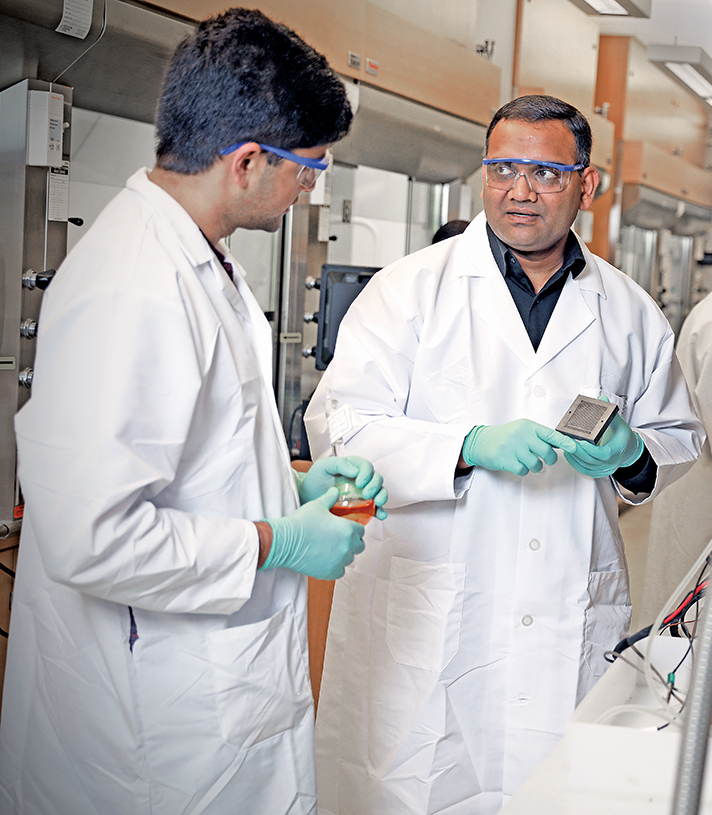
“Vijay’s work, in collaboration with others through InCEES, will help transform the way people and goods are transported in a more populated, increasingly urban society, where we are asked to feed more people while consuming fewer resources,” Pakrasi says.
While the term “electrochemical engineering” — the basis of Ramani’s work — sounds complex, he insists that if you can understand how a battery works, you can understand the basics of electrochemical engineering. “Today, almost everyone engages with it on a daily basis — for example, when you charge your phone or laptop,” says Ramani, who is also director of the Center for Solar Energy and Energy Storage at WashU and Faculty Fellow for Entrepreneurship for the Danforth Campus. “In my lab, we work on developing materials and systems that make electrochemical energy conversion and storage devices last longer in a cost-effective way.”
And, interestingly, the automotive industry champions Ramani’s research: He recently collaborated with Nissan to craft a durable catalyst that extends the life of a fuel-cell vehicle.
“Fuel-cell development for automobiles is an example of the kind of innovation happening all over Washington University that’s going to change the world,” says Provost Thorp. “Ramani’s research is such a great example of that. His work has very practical applications, and when explained, people can easily see why what he does is so important. But if you’re a hard-core electrochemist, you can read his papers and see that the basic science of what he does is exemplary as well.”
If implemented on a larger scale, hydrogen-powered cars could significantly slow the devastating effects of greenhouse gases. And while Ramani’s day-to-day work is full of making complex calculations, solving engineering-based problems, and leading a team of students and postdoctoral researchers, he views the current environmental crisis facing the globe as straightforward, back-of-the-envelope math.
“To face the problem, you first have to look at the impact of greenhouse-gas emissions, which lead to climate change,” he says. “To modulate the amount of carbon dioxide emitted — one major cause of the problem — you have to look at where it’s being produced: driving a gasoline- or diesel-powered automobile, and making electricity from coal or natural gas. It’s much more feasible to capture and sequester carbon-dioxide emissions in a large power plant, but it’s nearly impossible to do so from the tailpipes of millions of cars on the road,” Ramani says. “As you can imagine, the stakes are incredibly high.”
